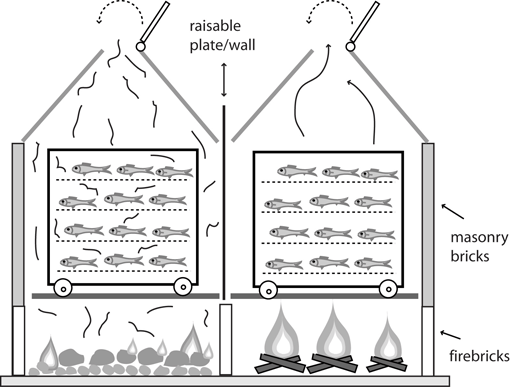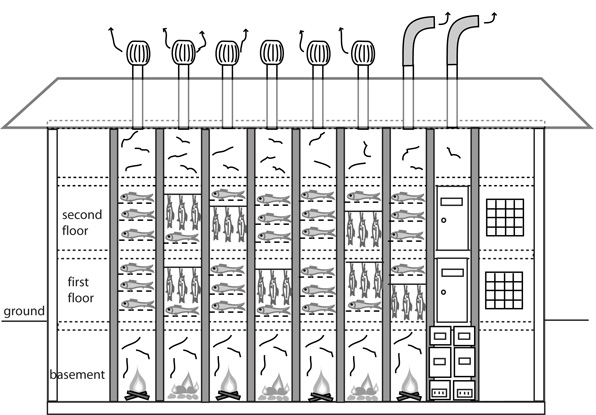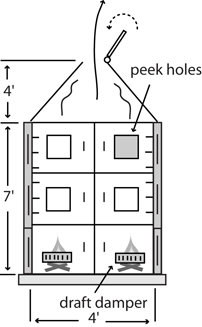Meats and Sausages
Commercial Smokehouses

Unit A - first generation multichamber smokehouse
Individual smokehouses were constructed on both sides of the chimney. That was a rather inefficient design as it required heating up not only each of the units (A) but the entire smokehouse chamber as well. Needless to say the wood usage was huge. The exiting smoke was controlled by a common to all chimney damper (5).
Unit B - improved design
A metal plate (1) was placed on top of each unit. This metal ceiling had an adjustable opening that was controlled by a flat metal damper (2). The weakness of this design was moisture gathered in the corners under the ceiling(p) which was dripping down on hanging products decreasing their looks and quality. The chimney damper was not needed anymore.
Unit C - second generation multichamber smokehouse
The next improvement was a design where each unit was independent of the others. It had a steep sloping conical ceiling (3) that provided an easier exit path for the smoke eliminating the problem of moisture pockets. The top of the ceiling was covered by an adjustable metal plate (4) that was controlled by a pull chain.
Improved design multichamber smokehouse
Improved design commercial smokehouses shared smoke exit channels that led into a common chimney. Some units could be dedicated to cold smoking and some to hot smoking as the areas were physically separated which allowed for finer temperature control. In some smokehouses each unit had its own exit channel that would enter a common chimney.

The size of the chimney was dictated by the size and the number of the individual units that shared that chimney. In most cases the front door consisted of three parts as shown in the drawing below.
Double-sided door was divided into three parts:
- Bottom door-provided access to the fire pit. It had built-in dampers for air supply control.
- Middle door-used for loading the fish. It had peek holes for checking progress of smoking.
- Top door-used for loading the fish.
Both sides were hinged and swung wide open for easy operation of the unit.
Separate smoking/cooking smokehouse
Another interesting innovation was the design of a smokehouse consisting of two traditional smokehouses that shared a common and movable divider wall. The bottom section of the divider wall was built from firebricks (3’ high) and a metal plate rested on top of it that would be pulled up and the fish cart would travel on rails from one unit to the other.
One unit was dedicated to drying/cooking fish at high temperatures without applying smoke and the second one was for smoking only. There was hardly any fire in a second unit (smoke producer) and only little occasional flames were seen on top of the wood chips.

It should be noted that some 100 years ago a preferred method of hot smoking consisted of three stages:
- Drying – 140°-194° F (60°-90° C)
- Baking – up to 250° F (122° C)
- Smoking – real smoking with a heavy smoke and dropping temperatures
A relatively strong and steady fire would be burning at 140°-250° F (60°-122° C) to dry/bake fish what would normally take 1-2 hours. Then the metal divider plate/wall would be raised and the cart would travel into the smoking chamber. The purpose of this unit was to produce heavy smoke which was accomplished by burning wood chips. All that was needed were small flames showing above the wood chips here and there. This process would normally last about two hours and the final temperature would be about 140° F (60° C).
That design saved fuel, time, and permitted cleaner and safer conditions in the plant. It also created well defined and separate areas of the operation:
- Fresh fish preparation-cleaning, washing, brining, loading.
- Drying/baking- steady fire allowing for easier temperature control.
- Smoking- constant smoke generation by burning wood chips.
- Cooling/packing-easier temperature control by controlling draft and using motor-driven fans.
Multilevel Smokehouses
Many three story buildings were converted into commercial smokehouses for smoking fish. A typical smokehouse would consist of:
- Basement-where a firebox/smoke producer would be located.
- First floor- smoke chamber.
- Second floor-smoke chamber.

Normally there would be from 3-10 individual smoke chambers. All of which that were divided by a masonry brick wall going all the way from the basement to the roof. The smoke would exit through an adjustable hinged door or through rotating wind turbines. The units were about 3’6” wide and up to 15 feet long. The width was more critical as the worker was using corbells (bricks) that protruded from the wall as a ladder. He was climbing them up to hang the smoke sticks that were passed to him from another worker standing below. On each wall there were about 20 corbells separated from each other by about 5 inches. Each unit on the second floor had its own door that gave access to the smoke chamber. After opening the door a wooden board was placed on top of the beams to provide a walkway for hanging more fish inside.














